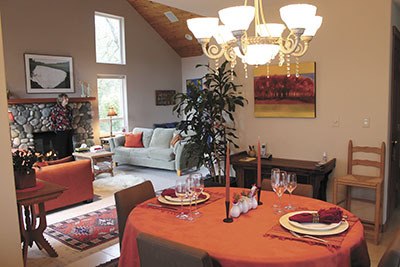When Pattie Hanmer first saw the clapboard house perched above Quartermaster Harbor, she knew she had found her Northwest home. Supported from behind by the wooded hillside, embraced on either side by tree-covered slopes and fronted by a vista of sparkling water, this dwelling had all the elements needed for ideal feng shui.
“It’s called the armchair,” said Hanmer, a feng shui professional and island resident since 2002. “The hill behind represents the back of the chair, which offers protection, and the trees on the sides form the arms.” The small rise beyond the water, in this case Maury Island, symbolizes the footstool. All combined, it’s a classic feng shui configuration.
The art of feng shui originated in ancient China and is all about the flow of energy or “chi” in a building and its environs. Keeping that chi moving depends upon the balance of the feminine and masculine energies — yin and yang — plus the prime energetic building blocks, the five elements of wood, fire, earth, metal and water.
Hanmer cites Northwest houses as examples of feng shui run amuck. They often have too much wood, which can stagnate energy. Solution? Add the element of metal.
“It can be as simple as painting a wall gray or adding a metal sculpture,” Hanmer said. “Think of it like an ax cutting through a log.”
Metaphors, it turns out, are big in feng shui.
So is making chi flow freely, which results in happy, healthy and productive residents. But how to get that energy moving is the question, and where the art comes in.
“This is not like the extreme makeover shows on TV,” laughed Hanmer who has been practicing feng shui for more than 20 years. “It has to happen gradually.”
And with Hanmer it does. Typically it takes about three months for clients to make the changes Hanmer suggests. After an extensive interview and walk through the house, Hanmer and her clients begin with a list. Paint a wall here, move some furniture there, buy something new.
One of the most common things blocking chi, Hanmer says, is clutter.
“It bogs you down,” she said. “We build a dam hanging onto old things. If you want something to change, then you have to release it. Always do what you’ve always done, and you get the same results.”
Hanmer’s proposals can be small to significant, but they often come down to what the clients most want changed in themselves.
“The house is like a mirror. I ask what they want to change, and it distills down to two things: relationships and money.”
Apparently, our energy gets stuck in things. Take one of Hanmer’s clients on Queen Anne. An attractive, successful business executive with a lovely house, this woman seemed to have it all — except in the world of romance. And that’s what the executive wanted to transform.
“She had boxes of letters from old boyfriends, hanging onto the pain and nostalgia of each breakup.”
Hanmer had the woman read each letter, and then they tore them up. The process took six to seven hours.
“Within the year, she called me up to say she was happily married,” Hanmer said.
With a twinkle in her eye, Hanmer said she loves to retell the dramatic success stories, but anyone can spruce up his or her home with a few feng shui touches.
Though Hanmer said there is no perfect feng shui, a good place to start is with your front door. Chi should flow into the house, so the entrance needs to be welcoming, beckoning you in. Once inside, the area to the left traditionally represents wealth.
“The Chinese use red to symbolize money and wealth,” Hanmer said. “Crystals stand for diamonds, and plants equal health and well-being. The left side in our house is the dining room, which includes the wealth of our friendships.”
The right side is for relationships. Hanmer displays two guitars for her and her husband’s, artist Dean Hanmer, love of music. There are two small cups from a wedding and other pairs of meaningful objects.
“Bird feeders and wind chimes bring in sound and movement,” added Hanmer. “Feng shui is a continual play of the elements and opening of avenues for the path of chi.”
Hanmer likes the energy of Vashon, she said. She feels it is a healing place with qualities that some of the other Puget Sound islands don’t have.
“There’s a subtle energy in the forms, the vistas and mountains, the presence of Mount Rainier. All the elements are here. It is a yin and yang island, deeply balanced.”


